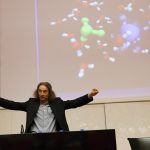Unraveling the complex nature of hydrated electrons in conventional and non-conventional ways

Prof. Pavel Jungwirth
Institute of Organic Chemistry and Biochemistry AS CR, v.v.i
Tuesday, April 12, 2016. 11:30 am
Assembly hall of Faculty of Science, 17. listopadu 12, Olomouc
Presentation:
Abstract:
Interaction of water with ionizing radiation is, in addition to DNA damage, also important for nuclear waste treatment. Upon photoionization in water an electron and a cationic hole are formed, and we have followed the fate of both species. In the talk, I focus on the structure and dynamics of the hydrated electron which, despite its key role in radiative processes in water, has remained elusive. The traditional cavity model has been questioned recently, but the newly suggested picture of an electron delocalized over a region of enhanced water density is controversial. Here, we present results from ab initio molecular dynamics simulations, where not only the excess electron but also the valence electrons of the surrounding water molecules are described quantum mechanically. Unlike in previous one-electron pseudopotential calculations, many-electron interactions are explicitly accounted for. The present approach allows for partitioning of the electron solvated in liquid water into contributions from an inner cavity, neighboring water molecules, and a diffuse tail. We demonstrate that all three of these contributions are sizable and, consequently, important, which underlines the complex nature of the hydrated electron and warns against oversimplified interpretations based on pseudopotential models. We also investigate the electron solvated at the water surface. The present results clearly demonstrate that the surface electron is mostly buried in the interfacial water layer, with only about ten percent of its density protruding into the vapor phase. Consequently, it has structure which is very similar to that of an electron solvated in the aqueous bulk. Finally, we show how to follow solvated electrons upon dissolving sodium in water (yes, it is explosive!).
Gallery






